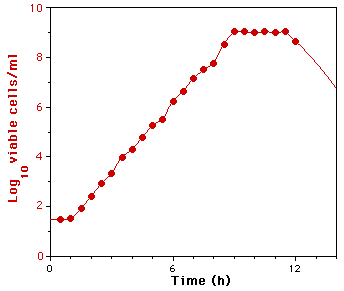
- During the LAG PHASE, the bacteria in the original inoculum adapt to their new environment (e.g. synthesise enzymes required for growth). The number of cells does not increase during this time (and under some circumstances may even decrease slightly). The lag phase is longest when there is the greatest difference between the previous and present growth conditions of the inoculum, e.g. when stationary phase cells are transferred to fresh medium or when cells in a rich medium are transferred to a nutrient-poor medium
- During the EXPONENTIAL or LOGARITHMIC PHASE of growth, the number of bacteria doubles at regular intervals. During the exponential phase, "balanced growth" occurs, i.e. a balanced increase in all cellular components (c.f. the lag phase, where de novo synthesis of new components, e.g enzymes, may occur).
- During the STATIONARY PHASE, the bacteria have exhausted one or more critical requirements for growth. Growth slows as wastes accumulate and/or nutrients are depleted. Bear in mind that a bacterial culture is a dynamic situation - individual cells are dividing or dying all the time. During the stationary phase, the rate of cell division is equal to the rate of cell death, thus the number of viable cells remains constant. Cells in the stationary phase have significantly different properties from those in the exponential phase of growth.
- During the DEATH or DECLINE PHASE, the rate at which cells die is greater than the rate at which they divide - hence the number of viable cells decreases. Note that there is a exponential decline in the number of cells during the death phase - the reciprocal of the logarithmic phase.
Calculate the GROWTH RATE CONSTANT and the MEAN GENERATION
TIME for this experiment


DISCLAIMER © AJC 2002.

